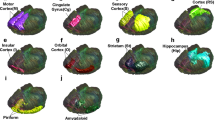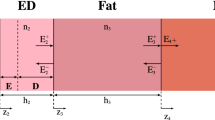Abstract
As electromagnetic exposure experiments can only be performed on small animals, usually rats, research on the characteristics of specific absorption rate (SAR) distribution in the rat has received increasing interest. A series of calculations, which simulated the SAR in a male rat anatomical model exposed to electromagnetic plane waves ranging from 0.05 to 5 GHz with different incidence and polarization, were conducted. The whole-body-averaged SAR (SARwb) and the tissue-averaged SAR (SARavg) in 20 major tissues were determined. Results revealed that incidence has great impact on SAR in the rat at higher frequencies owing to the skin effect and the effect on SARavg in tissues is much more apparent than that on SARwb; while polarization plays an important role under lower frequencies. Not only the incidence, but also the polarization in the rat keeps changing when the rat is in free movement. Thus, this article discussed a convenient way to obtain relatively accurate SARwb in a free-moving rat.









Similar content being viewed by others
References
Zhou H, Su Z, Ning J, Wang C, Xie X, Qu D, Yang G (2014) Effects of frequency, irradiation geometry and polarisation on computation of SAR in human brain. Radiat Prot Dosim 162(4):463–468
Li C, Lei Y, Li C, Xie Y, Wu T (2015) Dosimetric variability of the rats’ exposure to electromagnetic pulses. Electromagn Biol Med 34(4):334–343
Li C, Lei Y, Lu B, Yi X, Wu T (2016) A reverberation chamber for rodents’ exposure to wideband radiofrequency electromagnetic fields with different small-scale fading distributions. Electromagn Biol Med 35(1):30–39
Yang L, Hao D, Wu S, Zhong R, Zeng Y (2013) SAR and temperature distribution in the rat head model exposed to electromagnetic field radiation by 900 MHz dipole antenna. Australas Phys Eng S 36(2): 251–257
Findlay RP, Dimbylow PJ (2005) Effects of posture on fdtd calculations of specific absorption rate in a voxel model of the human body. Phys Med Biol 50(16):3825–3835
Nagaoka T, Watanabe S, Sakurai K, Kunieda E, Watanabe S, Taki M, Yamanaka Y (2004) Development of realistic high-resolution whole-body voxel models of Japanese adult males and females of average height and weight, and application of models to radio-frequency electromagnetic-field dosimetry. Phys Med Biol 49(1):1–16
Trakic A, Crozier S, Liu F (2004) Numerical modelling of thermal effects in rats due to high-field magnetic resonance imaging (0.5–1 GHz). Phys Med Biol 49(24):5547–5558
Li C, Chen Z, Yang L, Lv B, Liu J, Varsier N, Hadjem A, Wiart J, Xie Y, Ma L et al (2015) Generation of infant anatomical models for evaluating electromagnetic field exposures. Bioelectromagnetics 36(1):10–26
Mason PA, Hurt WD, Walters TJ, D’Andrea JA, Gajsek P, Ryan KL, Nelson DA, Smith KI, Ziriax JM (2000) Effects of frequency, permittivity, and voxel size on predicted specific absorption rate values in biological tissue during electromagnetic-field exposure. IEEE Trans Microw Theory 48 (11):2050–2058
Durney CH, Massoudi H, Iskander MF (1986) Radiofrequency radiation dosimetry handbook (fourth edition). Bioelectromagnetics 20(S4):46–51
Torres VJB (2007) Exposure systems and dosimetry of large-Scale in vivo studies. University of Santiago de Compostela
Nisbet HO, Nisbet C, Akar A, Cevik M, Karayigit MO (2012) Effects of exposure to electromagnetic field (1.8/0.9 GHz) on testicular function and structure in growing rats. Res Vet Sci 93(2):1001–1005
Ammari M, Lecomte A, Sakly M, Abdelmelek H, De-Seze R (2008) Exposure to GSM 900 MHz electromagnetic fields affects cerebral cytochrome coxidase activity. Toxicology 250(250):70–74
Bas O, Odaci E, Kaplan S, Acer N, Ucok K, Colakoglu S (2009) 900 MHz electromagnetic field exposure affects qualitative and quantitative features of hippocampal pyramidal cells in the adult female rat. Brain Res 1265:178–185
Dasdag S, Ketani MA, Akdag Z, Ersay AR, Sari I, Demirtas Ö C, Celik MS (1999) Whole-body microwave exposure emitted by cellular phones and testicular function of rats. Urol Res 27(3):219–223
Dasdag S, Zulkuf Akdag M, Aksen F, Yılmaz F, Bashan M, Mutlu Dasdag M, Salih Celik M (2003) Whole body exposure of rats to microwaves emitted from a cell phone does not affect the testes. Bioelectromagnetics 24(3):182–188
Ono T, Saito Y, Komura J, Ikehata H, Tarusawa Y, Nojima T, Goukon K, Ohba Y, Wang J, Fujiwara O, Sato R (2004) Absence of mutagenic effects of 2.45 GHz radiofrequency exposure in spleen, liver, brain, and testis of Lacz-transgenic mouse exposed in utero. Tohoku J Exp Med 202(2):93–103
Wang J, Fujiwara O, Kawai H, Wake K, Watanabe S (2008) Development and dosimetry analysis of a 2-GHz whole-body exposure setup for unrestrained pregnant and newborn rats. IEEE Trans Microw Theory 56(8):2008–2013
Jianqing W, Osamu F, Tetsuya O (2002) Dosimetry evaluation of a whole body exposure steup for small animal at 2.45 GHz. IEICE Trans Commun 85(12): 2963–2965
Wu T, Tan L, Shao Q, Zhang C, Zhao C, Li Y, Conil E, Hadjem A, Wiart J, Lu B et al (2011) Chinese adult anatomical models and the application in evaluation of RF exposures. Phys Med Biol 56(7):2075–2089
Gabriel C (1996) Compilation of the dielectric properties of body tissues at RF and microwave frequencies
Bakker JF, Paulides MA, Kuster N et al (2010) Assessment of induced SAR in children exposed to electromagnetic plane waves between 10 MHz and 5.6 GHz. Phys Med Biol 55(11):3115–3130
Gandhi OP (1980) State of the knowledge for electromagnetic absorbed dose in man and animals. Proc IEEE 68(1):24–32
Hirata A, Kodera S, Wang J, Fujiwara O (2007) Dominant factors influencing whole-body average SAR due to far-field exposure in whole-body resonance frequency and GHz regions. Bioelectromagnetics 28(6):484–487
Mcintosh RL, Deppeler L, Oliva M et al (2010) Comparison of radiofrequency exposure of a mouse dam and foetuses at 900 MHz. Phys Med Biol 55(4):111–122
Tongning W, Abdelhamid H, Man-Fai W, Azzedine G, Odile P, Joe W (2010) Whole-body new-born and young rats’ exposure assessment in a reverberating chamber operating at 2.4 GHz. Phys Med Biol 55(6):1619–1630
Chakarothai J, Wang J, Fujiwara O, et al. (2014) A Hybrid MoM/FDTD Method for Dosimetry of Small Animal in Reverberation Chamber. IEEE Trans Electromagn Compat, 56(56):549–558
Acknowledgements
This work was supported by the National Natural Science Fund, Grant No. 31600675 and the National Basic Research Program of China (973 Program), Grant No. 2011CB503701.
Author information
Authors and Affiliations
Corresponding author
Ethics declarations
Conflict of interest
The authors declare that they have no conflict of interest.
Research involving human and animal participants
The animal experiment was approved by the Animal Experimental Ethics Committee of East China Normal University.
Appendix
Appendix
Taking back irradiation for example, providing that the angle between the polarization and the long axis of the body is \(\uptheta\), the effect caused by the external electric field \(\left| \overrightarrow{E} \right|\) could be seen as the synergistic effect caused by the two fields, i.e. \(\left| \overrightarrow{E} \right|\cos \theta\) along the long axis and \(\left| \overrightarrow{E} \right|\sin \theta\) perpendicular to the long axis. As the electric field penetrates into the rat body, the value of these two fields in the body become \(\alpha \left| \overrightarrow{E} \right|\cos \theta\) and \(\beta \left| \overrightarrow{E} \right|\sin \theta\), respectively. α is the ratio of the electric field strength along the long axis inside to that outside the body. β is the ratio of the sselectric field strength perpendicular to the long axis inside to that outside the body.
As the random distribution of \(\theta\) in the interval \(\left[0,\frac{\pi }{2}\right]\), probability density function (PDF) is
In a word, the average SARwb under one incidence is equivalent to the SARwb when the angle between the body axis and the polarization is \({45}^{\circ}\).
Rights and permissions
About this article
Cite this article
Chen, B., Wang, J., Qi, H. et al. The specific absorption rate of tissues in rats exposed to electromagnetic plane waves in the frequency range of 0.05–5 GHz and SARwb in free-moving rats. Australas Phys Eng Sci Med 40, 21–28 (2017). https://doi.org/10.1007/s13246-017-0522-x
Received:
Accepted:
Published:
Issue Date:
DOI: https://doi.org/10.1007/s13246-017-0522-x




